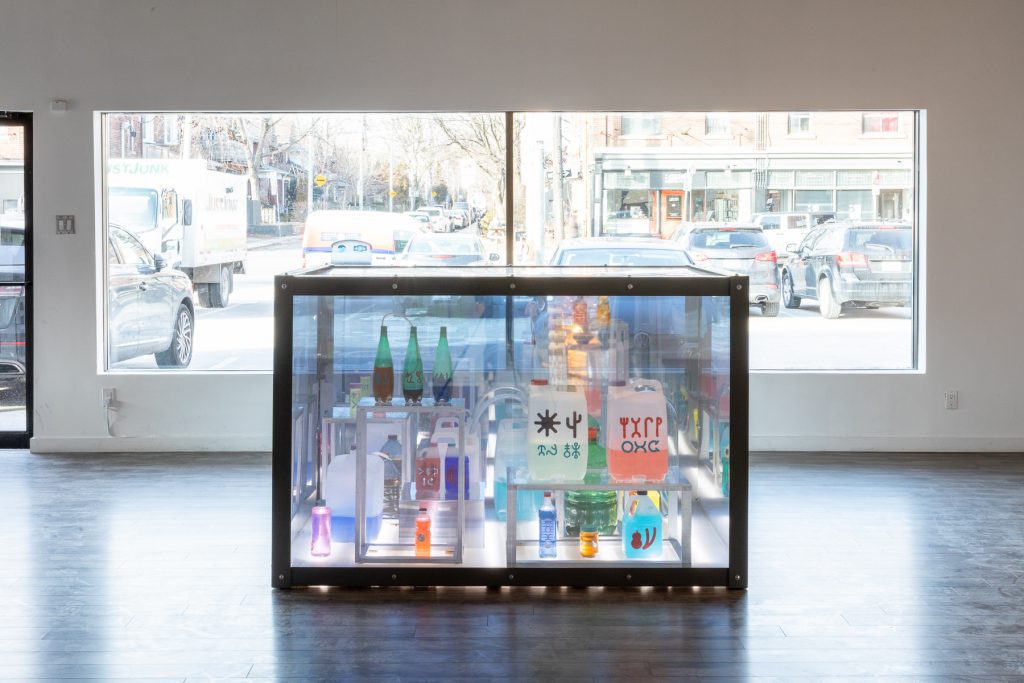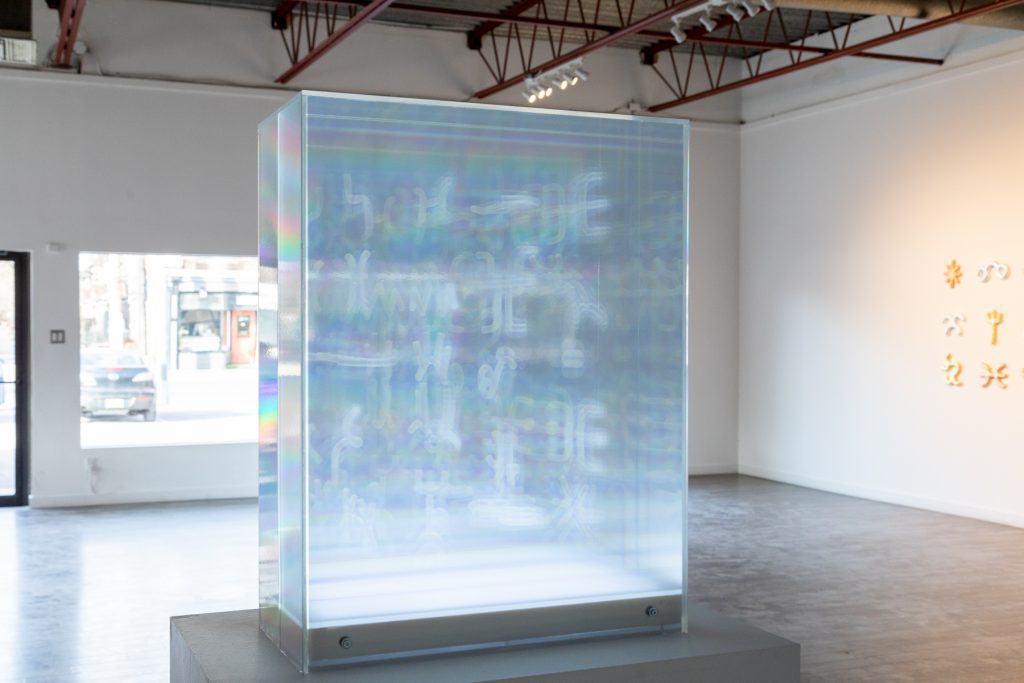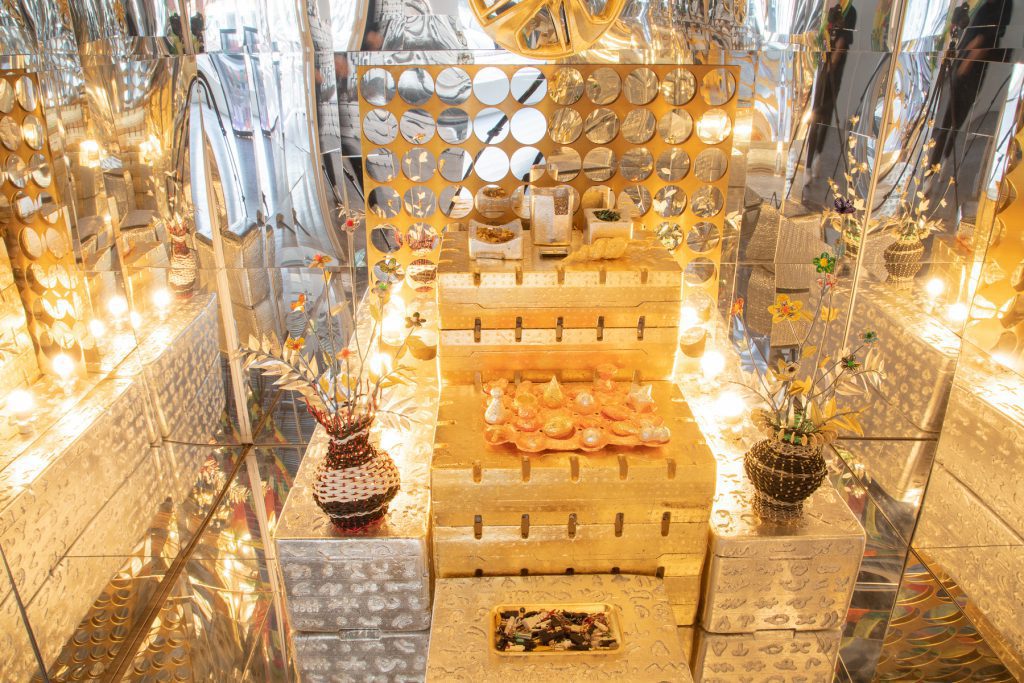Art for Future Humans: Camille Jodoin-Eng’s Earth Shrine
30 August 2021
By Megan MacLaurin
If the trajectory of our contemporary era is one of environmental destruction, how will this legacy be felt by people 10,000, or even 100,000 years from now? What will these future humans know about us?—that is, if our species manages to survive its own self-annihilating habits at all. One possible way to ensure we will be remembered is through shrines. Across time, shrines have codified and communicated the values of their makers, immortalizing the time and place of their creation by distilling what is considered sacred.
In her exhibition Earth Shrine at Patel Brown Gallery, Camille Jodoin-Eng creates a shrine to our current moment that venerates what capitalist-consumer society holds dearest: convenience and disposability. Using petrochemical consumer waste—plastic bottles and jugs, plastic sheets and netting, styrofoam blocks, and colourfully coated electrical wiring—Jodoin-Eng envisions a future where humankind is remembered for the inorganic refuse we leave behind, whose unnatural chemical compositions will vastly outlive us.
Artists, scientists, and philosophers alike have long wrestled with the challenge of communicating to future humans. Language is anything but static—the meanings of the words we use to express ourselves can observably change within a single human lifetime, and can become unrecognizable across centuries. This is why works of Old English literature like Beowulf (c. 700-1000) and Canterbury Tales (c. 1400) are indecipherable to most English readers today. The issue of delivering a message, unchanged, across the vast expanse of nuclear time is what writer and critic Lucy Lippard refers to as the “Forever Problem.”1 To describe this problem, Lippard discusses some of the projects proposed for the Waste Isolation Pilot Plant in Carlsbad, New Mexico in 1982, and the Yucca Mountain Nuclear Waste Repository in the Nevada desert in 2003, for which artists conceptualized artworks meant to demarcate the radioactive hazards of these nuclear storage sites.2 For the Yucca Mountain facility, Nevada’s Desert Space Foundation released a call for artists to develop a “universal warning sign” to identify the radioactivity of the repository in a way that would last ten millennia.3 Some submissions were infographics, like Maho Kishi’s Warning Sign, which illustrates a drill approaching an underground radioactive trefoil symbol alongside a stick figure shown keeled over on the ground. The prize-winning (though still unrealized) proposal belongs to Ashok Sukumaran, whose Blue Yucca Ridge is a field of unnaturally blue genetically altered Yucca plants, meant to signal the dangerous mutations possible through the site’s buried radioactive waste.4

In the exhibition, Camille Jodoin-Eng heralds the danger of another pervasive environmental contaminant: plastic. Plastic is everywhere—it lines the walls of our homes, is threaded through our clothing, seals the foods we eat, and it neatly collects everything we throw away. Plastic infiltrates our bodies as well, breaking down into microplastics that travel into and through our systems. Though they may not be a perfect solution to Lippard’s “Forever Problem,” Jodoin-Eng’s scavenged plastic assemblages may last a millennium, carrying forward the material realities of contemporary waste culture into a far away future.
In one assemblage, Water Shrine (2019), fluorescent liquids fill plastic jugs of various volumes, from gallon-size to small cosmetics bottles, that are enclosed within a large and brightly lit display case. The jugs and containers are each labelled with colourful abstract symbols. Asterisks, tridents, teardrops, swirls, squiggles, and suns hint toward the purposes of their contents. These labels appear to be stylized warning symbols, whose meanings remain unknown. Could our radioactive, flammable, and poison symbols be equally unrecognizable in the centuries to come? Beside this work, an assemblage of silver-painted styrofoam blocks, Future Ruins (2020), is piled high and connected using scrap wire, plastic bottle caps, and other detritus, resembling an inoperable control station. Encountering these mysterious arrangements feels like stumbling upon the artifacts of a future society wherein humankind’s languages have changed, but its reliance on plastic has not.
The symbols found marking the plastic jugs recur on the opposite wall. These symbols—roughly moulded from newspaper and encased in gold, silver, and bronze leaf—are mounted in three rows. My mind scrambles to decode their meanings; surely, characters so opulently displayed should carry importance, disclosing something significant to their beholder. These same symbols take new shape in Phantom Index (2019), a holographic tablet that encases more indecipherable phrases from Jodoin-Eng’s lexicon. In this work, characters from the artist’s unusual alphabet are formed from semi-transparent acrylic, refracted into iridescent bliss by a ground of mirror film. Vertically oriented atop a tall plinth, the work’s posture recalls the stone monoliths guarding the entrance to New Mexico’s Waste Isolation Pilot Plant, urging trespassers to turn back.

Instead, the work beckons me toward the exhibition’s titular installation, Earth Shrine (2020), a fully encompassing mirrored room adorned with plastic waste and defunct electronics. I remove my shoes to enter the room, pulling back a thick wooden door, and brushing past a patchwork of colourful netted plastic. Inside, incandescent lights reflected by the mirrored ceiling, floor, and walls create a wholly new climate, enrobing me in an inviting warmth. Within its balmy interior, two seats woven from scrap plastics rest before an altar of metallic styrofoam packing blocks, their gleaming surfaces inscribed with symbols to which I am now acutely familiar. Taking on a decorative function, the symbols resolve to a pattern beneath a multitude of oddities displayed upon this makeshift shrine. A copper-leaf-coated egg carton housing misshapen gold and silver orbs, faux flowers and vases fashioned from salvaged electrical wiring, and a dish of laser-etched acrylic tokens (bearing the artist’s distinct symbology) dress the altar. Within this shrine, a small golden bowl contains pseudo-ceremonial offerings of rusted USB connectors, earbuds, ethernet cables, and two-prong wall plugs all snipped from their wiring, manifesting missed signals and broken connections.
Earth Shrine—the exhibition and the various shrines it comprises—emulates one of the most time-worn methods for transmitting messages across deep time, which is religion. Millennia-old religions, like Hinduism, Judaism, and Buddhism, persist today through sacred texts, cultural traditions, and spaces of worship that embed the beliefs and values of their makers. Jodoin-Eng aptly constructs her shrine (and religion) from petrochemical waste, articulating humankind’s pious adoration of consumer products, carefully packaged and efficiently delivered, only to crowd our homes until we inevitably discard them. Jodoin-Eng’s shrine challenges the apparent disposability of plastics, conflating the long lifespan of plastic with the historical endurance of religion. Earth Shrine immortalizes our contemporary environmental crisis by communicating consumer capitalist values, and their demise, as a cautionary tale for future humans.
- Lucy R. Lippard, Undermining: A Wild Ride Through Land Use, Politics, and Art in the Changing West (The New Press, 2014): 119.
- Ibid., 119-120.
- Hugh Hart, “A design show for the ages,” Los Angeles Times, October 15, 2003 https://www.latimes.com/archives/la-xpm-2003-oct-15-et-hart15-story.html.
- Ibid.
Earth Shrine ran from January 9 – February 23, 2020 at Patel Brown Gallery in Toronto, ON.
Feature Image: Earth Shrine, 2020 by Camille Jodoin-Eng. Courtesy of Patel Brown Gallery.



